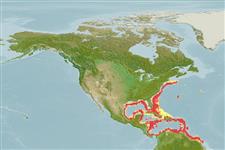Environment: milieu / climate zone / depth range / distribution range
экология
морской батидемерсальный; немигрирующий; пределы глубины 80 - 1170 m (Ref. 1371), usually 160 - 640 m (Ref. 1371). Deep-water; 42°N - 4°N, 98°W - 50°W (Ref. 58452)
Western Central Atlantic: Georges Bank, New England to Suriname and French Guiana.
Length at first maturity / Size / Вес / Возраст
Maturity: Lm 28.0 range ? - ? cm
Max length : 40.6 cm TL самец/пол неопределен; (Ref. 1371); 70.0 cm TL (female); common length : 30.0 cm TL самец/пол неопределен; (Ref. 1371); common length :45 cm TL (female); наибольший вес (опубликованные данные): 0.00 g
колючие лучи спинного плавника (общее число) : 1; членистые (мягкие) лучи спинного плавника (общее число) : 45 - 51; колючие лучи анального плавника: 0; членистые (мягкие) лучи анального плавника: 35 - 41; позвонки: 51 - 53. Head rather long; mouth large; gill rakers short and thick, with blunt tips; pectoral fin tips reaching a vertical through anus in small fish but not in larger ones; overall color silvery white (Ref. 1371).
Offshore species which inhabit the outer part of the continental shelf and upper part of the slope. Feed at night when they come up towards the surface (Ref. 1371). Juveniles feed primarily on crustaceans (Ref. 58452). Adults' food consists primarily of fishes (particularly lantern fishes, sardines and anchovies) and, to a lesser extent, crustaceans and squids (Ref. 1371). Spawning occurs near the bottom at 330-550 m depth range from April to July in New England and from late spring to early autumn in the Gulf of Mexico and the Carribean Sea (Ref. 58452). Marketed fresh, frozen and smoked.
Cohen, D.M., T. Inada, T. Iwamoto and N. Scialabba, 1990. FAO species catalogue. Vol. 10. Gadiform fishes of the world (Order Gadiformes). An annotated and illustrated catalogue of cods, hakes, grenadiers and other gadiform fishes known to date. FAO Fish. Synop. 125(10). Rome: FAO. 442 p. (Ref. 1371)
Статус Красного Списка МСОП (Ref. 130435)
Угроза для людей
Harmless
Использование человеком
рыболовство: не имеет хозяйственного значения
дополнительная информация
инструменты
Специальные отчеты
Скачать в формате XML
ресурсы в Интернет
Estimates based on models
Preferred temperature (Ref.
123201): 7.1 - 20.5, mean 12.6 °C (based on 182 cells).
Phylogenetic diversity index (Ref.
82804): PD
50 = 0.5000 [Uniqueness, from 0.5 = low to 2.0 = high].
Bayesian length-weight: a=0.00759 (0.00453 - 0.01269), b=3.01 (2.86 - 3.16), in cm total length, based on LWR estimates for this species & (Sub)family-body (Ref.
93245).
Trophic level (Ref.
69278): 3.4 ±0.0 se; based on diet studies.
Generation time: 2.3 ( na - na) years. Estimated as median ln(3)/K based on 2
growth studies.
устойчивость к внешним воздействиям (Ref.
120179): средний (среднего размера), минимальное время удвоения популяции 1.4-4.4 года (Assuming tmax > 3 and tm >=2; K=0.57; Fec=340,000).
Fishing Vulnerability (Ref.
59153): Low to moderate vulnerability (30 of 100).
Climate Vulnerability (Ref.
125649): Low to moderate vulnerability (29 of 100).
Nutrients (Ref.
124155): Calcium = 16.3 [7.2, 65.7] mg/100g; Iron = 0.484 [0.080, 1.352] mg/100g; Protein = 17.2 [15.7, 18.6] %; Omega3 = 0.252 [0.112, 0.506] g/100g; Selenium = 24.9 [9.8, 55.4] μg/100g; VitaminA = 11 [2, 52] μg/100g; Zinc = 0.301 [0.197, 0.490] mg/100g (wet weight);
